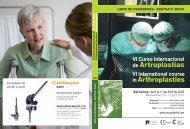cadera / hip - Active Congress.......
cadera / hip - Active Congress.......
cadera / hip - Active Congress.......
You also want an ePaper? Increase the reach of your titles
YUMPU automatically turns print PDFs into web optimized ePapers that Google loves.
JUEVES / THURSDAY<br />
240<br />
to the mechanical axis of the lower extremity,<br />
and roughly parallel to the epicondylar axis.<br />
In the fl exed position, anatomic landmarks<br />
are equally important for varus-valgus alignment.<br />
Incorrect varus-valgus alignment in<br />
fl exion not only malaligns the long axes of<br />
the femur and tibia, but also incorrectly positions<br />
the patellar groove both in fl exion and<br />
extension.<br />
Finding suitable landmarks for varus-valgus<br />
alignment has led to efforts to use the posterior<br />
femoral condyles, epicondylar axis, and<br />
anteroposterior (AP) axis of the femur. The<br />
posterior femoral condyles provide excellent<br />
rotational alignment landmarks if the femoral<br />
joint surface has not been worn or otherwise<br />
distorted by developmental abnormalities or<br />
the arthritic process. However, as with the<br />
distal surfaces, the posterior femoral condylar<br />
surfaces sometimes are damaged or<br />
hypoplastic (more commonly in the valgus<br />
than in the varus knee) and cannot serve as<br />
reliable anatomic guides for alignment. The<br />
epicondylar axis is anatomically inconsistent<br />
and in all cases other than revision total<br />
knee arthroplasty with severe bone loss,<br />
is unreliable for varus-valgus alignment in<br />
fl exion just as it is in extension. The AP axis,<br />
defi ned by the lateral border of the posterior<br />
cruciate ligament posteriorly and the deepest<br />
part of the patellar groove anteriorly, is<br />
highly consistent, and always lies within the<br />
median sagittal plane that bisects the lower<br />
extremity, passing through the <strong>hip</strong>, knee,<br />
and ankle. When the articular surfaces are<br />
resected perpendicular to the AP axis, they<br />
are perpendicular to the AP plane, and the<br />
extremity can function normally in this plane<br />
throughout the arc of fl exion.<br />
In the valgus knee with signifi cant posterior<br />
deformity or erosion, the posterior femoral<br />
condyles are unreliable as rotational alignment<br />
landmarks, and the anteroposterior axis<br />
provides a reliable landmark for rotational<br />
alignment of the femoral surface cuts.<br />
Technique for Femoral Bone Resection<br />
Intramedullary alignment instruments usually<br />
are used for the femoral resection. The<br />
distal femoral surfaces are resected at a<br />
valgus angle of 5-7°. A medialized entry<br />
point generally is advised because the distal<br />
femur curves toward valgus in the valgus<br />
knee. The current technique is to reference<br />
the resection from the distal medial femoral<br />
surface. The distal femoral cutting guide is<br />
seated on the distal surface of the medial<br />
femoral condyle, which is resected equal to<br />
the thickness of the distal condylar surface<br />
of the implant. If the distal lateral femoral<br />
condylar surface is defi cient, considerably<br />
less is resected from the lateral surface than<br />
from the medial surface, and in many cases<br />
of a severe valgus angle, no bone is present<br />
to resect from the distal lateral surface.<br />
Seating on bone is necessary on the lateral<br />
distal side, but this can be accomplished with<br />
the anterior lateral bevel surface. In cases<br />
of severely defi cient lateral femoral condylar<br />
bone stock, the anterior bevel surface is the<br />
only bony contact for the distal lateral surface<br />
of the femoral component. This leaves a gap<br />
that is fi lled with bone graft between the distal<br />
bone surface and the inner surface of the implant<br />
on the lateral side. When the posterior<br />
fl ange and the anterior bevel surfaces are<br />
seated on viable bone, the distal defect can<br />
be treated as a contained defect and needs<br />
no structural grafting. Rotational alignment of<br />
the distal femoral cutting guide is adjusted to<br />
resect the anterior and posterior surfaces perpendicular<br />
to the anteroposterior axis of the<br />
femur. The AP axis is drawn and the femoral<br />
cutting guides are aligned to make the cuts<br />
perpendicular to this line. In the valgus knee<br />
this almost always results in much greater<br />
posteromedial than posterolateral femoral<br />
condylar resection.<br />
Technique for Tibial Bone Resection<br />
Intramedullary alignment instruments are<br />
used to real tibial surface is based on the<br />
height of the intact medial bone surface. A<br />
maximum thickness of 10 mm is removed





